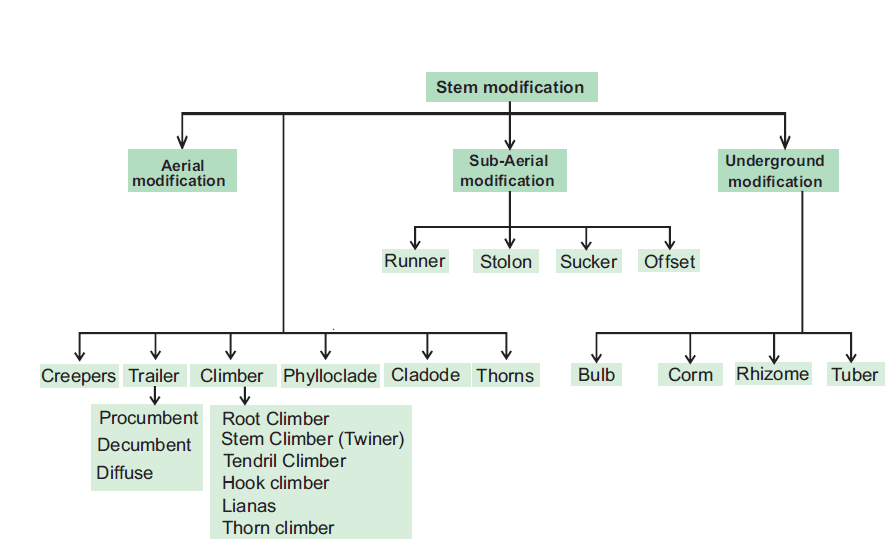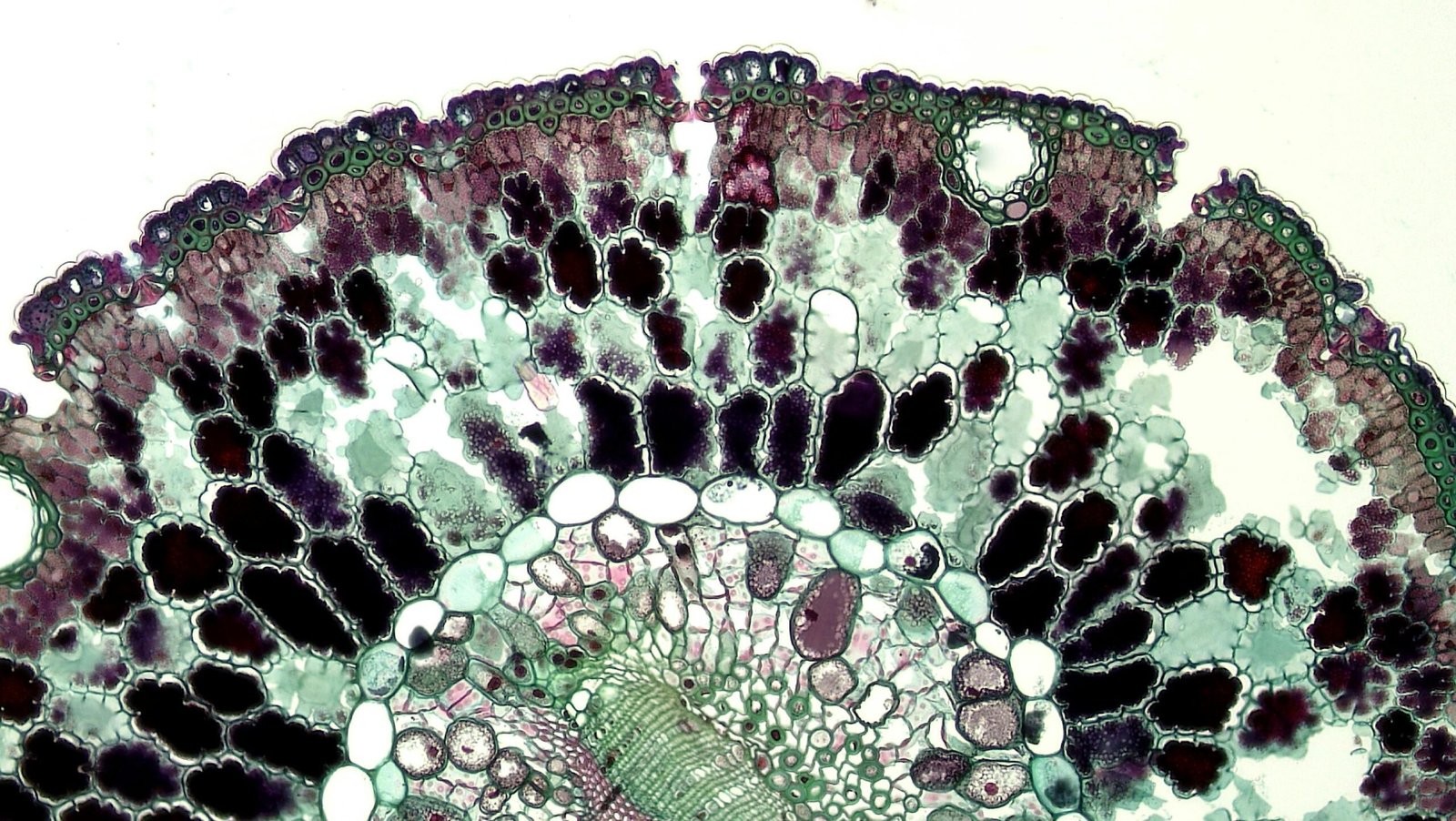The shoot system in plants is composed of the aerial parts, including the stem, leaves, flowers, fruits, and buds. The stem, being a major part of the shoot system, provides structural support and serves as the main conduit for transporting water, minerals, and food. In this blog post, we will explore the characteristic features of the stem, its functions, various types of stems, buds, and the numerous modifications and adaptations that make the stem a versatile part of plant anatomy.
1. Characteristic Features of the Stem
The stem is a vital component of a plant’s anatomy. It exhibits several distinct characteristics that differentiate it from other plant parts:
- Aerial Organ: The stem generally grows above the ground, unlike roots.
- Nodes and Internodes: The stem is divided into nodes (points where leaves or buds are attached) and internodes (regions between nodes).
- Buds: Stems bear buds at the nodes, which can develop into leaves, flowers, or branches.
- Positive Phototropism: Stems grow towards the source of light.
- Absence of Root Cap: Unlike roots, stems do not have a protective root cap at the growing tip.
- Green and Soft in Early Stages: In young plants, stems are usually green and capable of photosynthesis, turning woody and brown as they mature.
- Branching: Stems can branch out into new stems, supporting leaves and flowers.
- Vascular Bundles: The stem contains vascular bundles (xylem and phloem) responsible for transporting water, nutrients, and food.
2. Functions of the Stem
The stem plays a multifaceted role in the growth and survival of a plant. Some of the key functions include:
- Support: The stem provides structural support for leaves, flowers, and fruits, positioning them for optimal sunlight and pollination.
- Transport: Through the xylem and phloem, stems facilitate the transport of water, nutrients, and food between roots and leaves.
- Photosynthesis: In herbaceous and young plants, stems perform photosynthesis.
- Storage: Stems can store nutrients and water in some plant species.
- Vegetative Propagation: Certain stems reproduce asexually, giving rise to new plants.
- Protection: In some plants, stems bear thorns to protect against herbivores.
- Climbing: In plants like vines, the stem supports climbing structures such as tendrils, allowing the plant to reach sunlight.
3. Buds
Buds are undeveloped or embryonic shoots typically found at the axils of leaves or at the terminal end of the stem. There are two main types of buds:
- Terminal Bud: Found at the tip of the stem, responsible for upward growth.
- Axillary Bud: Found at the leaf axils, responsible for the formation of branches, flowers, or leaves.
Buds are further classified based on their function:
- Vegetative Bud: Develops into leaves or branches.
- Flower Bud: Develops into a flower.
- Mixed Bud: Capable of developing into both a flower and vegetative structures.
4. Types of Stem

Stems come in various forms depending on the plant’s habitat and growth requirements:
- Herbaceous Stems: Soft, non-woody, and flexible stems found in plants like spinach and mint.
- Woody Stems: Hard and rigid stems that make up trees and shrubs like oak and rose.
- Climbing Stems: Found in plants like vines and creepers (e.g., grapevine), using external support for growth.
- Creeping Stems: These stems grow horizontally along the ground (e.g., grasses).
- Aerial Stems: Stems that grow above the ground in the typical upward direction.
- Subterranean Stems: Stems that grow underground, often storing nutrients.

5. Modification of Stem
Stems have evolved various modifications to perform specialized functions. These modifications can be categorized as underground, subaerial, and aerial stem modifications.
A. Underground Stem Modifications

Underground stems perform functions like storage of food, vegetative reproduction, and perennation (survival during unfavorable conditions). Types include:
- Rhizome: A horizontal, underground stem that stores food.
Example: Ginger. - Tuber: A swollen, underground stem that stores food in the form of starch.
Example: Potato. - Bulb: A short, underground stem surrounded by fleshy leaves storing food.
Example: Onion. - Corm: A swollen, underground stem with a solid structure, storing nutrients.
Example: Gladiolus, taro.
B. Subaerial Stem Modifications

These stems grow partly above and partly below the ground and are primarily involved in vegetative propagation. Types include:
- Runner: A horizontal stem that grows along the ground and gives rise to new plants.
Example: Strawberry. - Stolon: Similar to runners but arches downward into the soil, forming new plants.
Example: Jasmine. - Sucker: A stem arises from underground and grows vertically to form a new plant.
Example: Mint. - Offset: A short, thickened horizontal stem that produces new plants in aquatic environments.
Example: Water hyacinth.

C. Aerial Stem Modifications
Aerial stems develop modifications that help plants survive in specific environments:
- Tendrils: Slender, coiled stems that provide support for climbing.
Example: Grape vine. - Thorns: Sharp, pointed structures that protect plants from herbivores.
Example: Bougainvillea. - Phylloclades: Flattened stems that perform photosynthesis.
Example: Opuntia (prickly pear).
6. Stem Branching
Stem branching is the process where stems produce lateral shoots (branches). There are two main types of branching:
- Monopodial Branching: The main stem continues to grow indefinitely, while lateral branches grow sideward.
Example: Pine, eucalyptus. - Sympodial Branching: The terminal bud stops growing, and the lateral buds take over growth, leading to a branching pattern.
Example: Mango, cotton.
Conclusion
The shoot system—especially the stem—plays a critical role in plant development. Whether it’s providing support, storing food, or facilitating photosynthesis, the stem is central to the plant’s overall health. Stems have evolved to adapt to different environmental conditions, showing great versatility in their form and function through various modifications.
